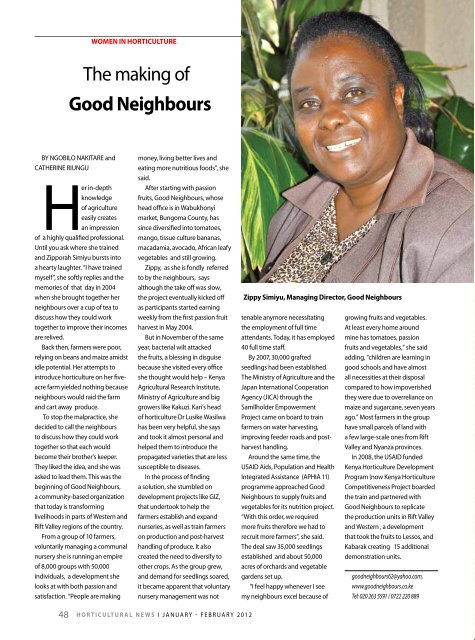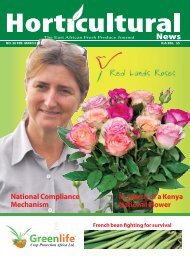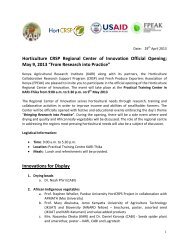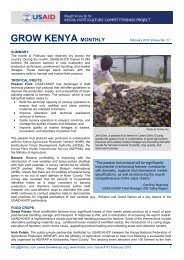Horticultural News January - February issue
Horticultural News January - February issue
Horticultural News January - February issue
You also want an ePaper? Increase the reach of your titles
YUMPU automatically turns print PDFs into web optimized ePapers that Google loves.
By nGOBILO naKITarE and<br />
CaTHErInE rIunGu<br />
Her in-depth<br />
knowledge<br />
of agriculture<br />
easily creates<br />
an impression<br />
of a highly qualified professional.<br />
until you ask where she trained<br />
and Zipporah Simiyu bursts into<br />
a hearty laughter. “I have trained<br />
myself”, she softly replies and the<br />
memories of that day in 2004<br />
when she brought together her<br />
neighbours over a cup of tea to<br />
discuss how they could work<br />
together to improve their incomes<br />
are relived.<br />
Back then, farmers were poor,<br />
relying on beans and maize amidst<br />
idle potential. Her attempts to<br />
introduce horticulture on her fiveacre<br />
farm yielded nothing because<br />
neighbours would raid the farm<br />
and cart away produce.<br />
To stop the malpractice, she<br />
decided to call the neighbours<br />
to discuss how they could work<br />
together so that each would<br />
become their brother’s keeper.<br />
They liked the idea, and she was<br />
asked to lead them. This was the<br />
beginning of Good neighbours,<br />
a community-based organization<br />
that today is transforming<br />
livelihoods in parts of Western and<br />
rift Valley regions of the country.<br />
From a group of 10 farmers,<br />
voluntarily managing a communal<br />
nursery she is running an empire<br />
of 8,000 groups with 50,000<br />
individuals, a development she<br />
looks at with both passion and<br />
satisfaction. “People are making<br />
48<br />
The making of<br />
Good Neighbours<br />
money, living better lives and<br />
eating more nutritious foods”, she<br />
said.<br />
after starting with passion<br />
fruits, Good neighbours, whose<br />
head office is in Wabukhonyi<br />
market, Bungoma County, has<br />
since diversified into tomatoes,<br />
mango, t<strong>issue</strong> culture bananas,<br />
macadamia, avocado, african leafy<br />
vegetables and still growing.<br />
Zippy, as she is fondly referred<br />
to by the neighbours, says<br />
although the take off was slow,<br />
the project eventually kicked off<br />
as participants started earning<br />
weekly from the first passion fruit<br />
harvest in May 2004.<br />
But in november of the same<br />
year, bacterial wilt attacked<br />
the fruits, a blessing in disguise<br />
because she visited every office<br />
she thought would help – Kenya<br />
agricultural research Institute,<br />
Ministry of agriculture and big<br />
growers like Kakuzi. Kari’s head<br />
of horticulture Dr Lusike Wasilwa<br />
has been very helpful, she says<br />
and took it almost personal and<br />
helped them to introduce the<br />
propagated varieties that are less<br />
susceptible to diseases.<br />
In the process of finding<br />
a solution, she stumbled on<br />
development projects like GIZ,<br />
that undertook to help the<br />
farmers establish and expand<br />
nurseries, as well as train farmers<br />
on production and post-harvest<br />
handling of produce. It also<br />
created the need to diversify to<br />
other crops. as the group grew,<br />
and demand for seedlings soared,<br />
it became apparent that voluntary<br />
nursery management was not<br />
H O R T I C U LT U R A L N E W S I j a n u a r y - F E B r u a r y 2 0 1 2<br />
Zippy Simiyu, Managing Director, Good Neighbours<br />
tenable anymore necessitating<br />
the employment of full time<br />
attendants. Today, it has employed<br />
40 full time staff.<br />
By 2007, 30,000 grafted<br />
seedlings had been established.<br />
The Ministry of agriculture and the<br />
japan International Cooperation<br />
agency (jICa) through the<br />
Samllholder Empowerment<br />
Project came on board to train<br />
farmers on water harvesting,<br />
improving feeder roads and postharvest<br />
handling.<br />
around the same time, the<br />
uSaID aids, Population and Health<br />
Integrated assistance (aPHIa 11)<br />
programme approached Good<br />
neighbours to supply fruits and<br />
vegetables for its nutrition project.<br />
“With this order, we required<br />
more fruits therefore we had to<br />
recruit more farmers”, she said.<br />
The deal saw 35,000 seedlings<br />
established and about 50,000<br />
acres of orchards and vegetable<br />
gardens set up.<br />
“I feel happy whenever I see<br />
my neighbours excel because of<br />
growing fruits and vegetables.<br />
at least every home around<br />
mine has tomatoes, passion<br />
fruits and vegetables,” she said<br />
adding, “children are learning in<br />
good schools and have almost<br />
all necessities at their disposal<br />
compared to how impoverished<br />
they were due to overreliance on<br />
maize and sugarcane, seven years<br />
ago.” Most farmers in the group<br />
have small parcels of land with<br />
a few large-scale ones from rift<br />
Valley and nyanza provinces.<br />
In 2008, the uSaID funded<br />
Kenya Horticulture Development<br />
Program (now Kenya Horticulture<br />
Competitiveness Project boarded<br />
the train and partnered with<br />
Good neighbours to replicate<br />
the production units in rift Valley<br />
and Western , a development<br />
that took the fruits to Lessos, and<br />
Kabarak creating 15 additional<br />
demonstration units.<br />
goodneighbours62@yahoo.com,<br />
www.goodneighbours.co.ke<br />
Tel: 020 263 5591 / 0722 220 889












